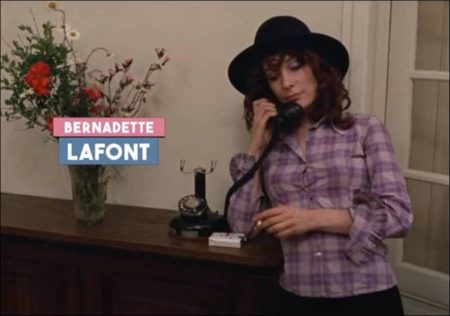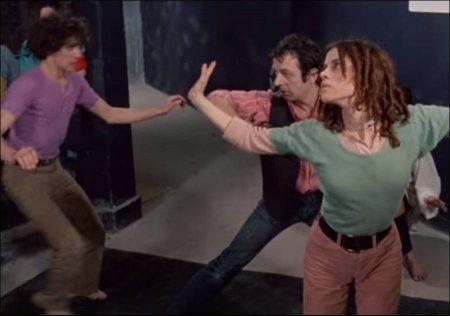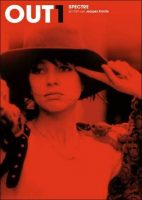“Out 1” is a very precise picture of post May 1968 malaise – when Utopian dreams of a new society had crashed and burned, radical terrorism was starting to emerge in unlikely places and a great many other things. Two marginals who don’t know one another stumble into the remnants of a “secret society”: Colin, a seemingly deaf-mute who all of a sudden begins to talk and Frederique, a con artist working the “short con” (stealing drinks and tricking men who think she’s a hooker out of their money).
Meanwhile, there are two theater groups rehearsing classic Greek dramas: “Seven Against Thebes” and “Prometheus Bound”. A member of the Moretti group passes a note to Leaud about “The 13” which sends Leaud on a search for “The 13”. His search brings him eventually to Bulle Ogier’s shop in Les Halles “L’Angle du Hasard.” Berto follows much the same path when she steals a cachet of letters from Jacques Doniol-Valcroze and tries to get money from their owners for their return. These twin activities reactivate “The 13”, which had been dormant for years, revealing, among other things, that the two theater groups were once one.
Out 1, also referred to as Out 1: Noli Me Tangere, is a 1971 French film directed by Jacques Rivette. It is indebted to Honoré de Balzac’s La Comédie humaine, particularly the History of the Thirteen collection (1833–35). Known for its length of nearly 13 hours, the film is divided into eight parts around 90–100 minutes each.
The vast length of Out 1 allows Rivette, like Balzac, to construct multiple loosely connected characters with independent stories whose subplots weave amongst each other and continually uncover new characters with their own subplots. A shorter version of the film exists, and its Spectre subtitle was chosen for the name’s ambiguous and various indistinct meanings, while the Noli me tangere (“touch me not”) subtitle for the original version is clearly a reference to it being the full-length film as intended by Rivette.
The film’s experimentation with parallel subplots was influenced by André Cayatte’s two-part Anatomy of a Marriage (1964), while the use of expansive screen time was first toyed with by Rivette in L’amour fou (1969). The parallel narrative structure has since been used in many other notable films, including Krzysztof Kieślowski’s Dekalog and Lucas Belvaux’s Trilogie, which includes Un couple épatant, Cavale and Après la vie, to name a few.
Each part begins with a title in the form of “from person to person” (usually indicating the first and last characters seen in each episode), followed by a handful of black and white still photos recapitulating the scenes of the prior episode, then concluded by showing the final minute or so (in black and white) of the last episode before cutting into the new episode itself (which is entirely in color).
Style of the Film
After working with both 35mm film and 16mm film in L’amour fou, Rivette was comfortable enough with the 16mm format to work with it on Out 1, the massive length of which precluded any serious attempt to shoot the whole film on expensive 35mm. Despite the immense length of the final product, the film was shot under a tight shooting schedule of only six weeks.
Rivette’s preference for the long take was the main reason why such a schedule could be maintained. Because he wanted the performances to have a level of realism, some takes include lines “fluffed” by actors, or other common “mistakes” such as camera and boom microphone shadows, as well as unwitting extras looking at the camera in exterior shots (including a well-known scene where two young boys doggedly follow Jean-Pierre Léaud along the street during an extended monologue).
Rivette has said that the intimacy of the performances in the face of such mistakes was precisely why he kept those takes in the film. Many of the rehearsal scenes, particularly those of the Prometheus Bound group, are composed almost entirely of long shots, although the film also contains more conventional editing elsewhere.
The slow pacing of the film as a whole is also loosely based on Balzac,[original research?] and its first few hours are constructed more like a prologue, where the editing is slower and the characters are no more than introduced. It is not until three or four hours into the film that characters’ motives and the story lines begin to reveal themselves.
The work also includes stylistically adventurous techniques, including the shooting of long shots through mirrors (again developing from work in L’amour fou), short cuts to black to punctuate otherwise continuous scenes, short cutaways to unrelated or seemingly meaningless shots, non-diegetic sound blocking out crucial parts of the dialogue, and even a conversation in which selected lines are re-edited so that they appear to be spoken backward. However, these experiments form a fairly small part of the work as a whole, which is generally conventional in style (aside from the length of takes and of the work as a whole).
Out 1: Noli Me Tangere (1971)
Directed by: Jacques Rivette, Suzanne Schiffman
Starring: Jean-Pierre Léaud, Juliet Berto, Michèle Moretti, Michael Lonsdale, Bernadette Lafont, Bulle Ogier, Françoise Fabian, Hermine Karagheuz, Michel Delahaye, Christian de Tillière
Screenplay by: Jacques Rivette, Suzanne Schiffman
Production Design by: Jean-Claude Valezy
Cinematography by: Pierre-William Glenn
Film Editing by: Nicole Lubtchansky
Music by: Jean-Pierre Drouet
MPAA Rating: None.
Distributed by: Sunshine Productions
Release Date: October 9, 1971
Visits: 115


